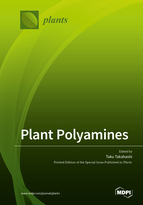Plant Polyamines
A special issue of Plants (ISSN 2223-7747). This special issue belongs to the section "Plant Physiology and Metabolism".
Deadline for manuscript submissions: closed (31 May 2019) | Viewed by 46735
Special Issue Editor
Special Issue Information
Dear Colleagues,
Polyamines are ubiquitous natural compounds and, as polycations with their primary and secondary amino groups protonated, interact with negatively charged macromolecules, such as DNA, RNA, and proteins, to modulate their activities. In plants, polyamines are involved in a variety of physiological processes. They are also metabolized in certain flowering plants into nitrogen-containing specialized metabolites including nicotine, tropane and pyrrolizidine alkaloids. One unique feature of plant polyamines is the widespread occurrence of thermospermine from primitive algae to land plants. However, it’s only after the turn of the century that the specific function of thermospermine in plant vascular development was identified. On the other hand, its structural isomer spermine has been implicated in biotic and abiotic stress response. Spermine catabolism is also proposed to be a key source of hydrogen peroxide in the stress response although there are some uncertainty about which is more important, accumulation of polyamines or catabolism of them. Polyamines are also present as a conjugated form with cinnamic acids and proteins and the genes responsible for these conjugations have been increasingly identified. This Special Issue of Plants will highlight new discoveries about the metabolism and function of plant polyamines and help to stimulate further research. I also hope that it will make readers aware of the link between their own work and topics related to polyamines.
Prof. Taku Takahashi
Guest Editor
Manuscript Submission Information
Manuscripts should be submitted online at www.mdpi.com by registering and logging in to this website. Once you are registered, click here to go to the submission form. Manuscripts can be submitted until the deadline. All submissions that pass pre-check are peer-reviewed. Accepted papers will be published continuously in the journal (as soon as accepted) and will be listed together on the special issue website. Research articles, review articles as well as short communications are invited. For planned papers, a title and short abstract (about 100 words) can be sent to the Editorial Office for announcement on this website.
Submitted manuscripts should not have been published previously, nor be under consideration for publication elsewhere (except conference proceedings papers). All manuscripts are thoroughly refereed through a single-blind peer-review process. A guide for authors and other relevant information for submission of manuscripts is available on the Instructions for Authors page. Plants is an international peer-reviewed open access semimonthly journal published by MDPI.
Please visit the Instructions for Authors page before submitting a manuscript. The Article Processing Charge (APC) for publication in this open access journal is 2700 CHF (Swiss Francs). Submitted papers should be well formatted and use good English. Authors may use MDPI's English editing service prior to publication or during author revisions.
Keywords
- stress response
- growth and development
- polyamine oxidation
- polyamine conjugation
- polyamine transport
- alkaloids
- gene evolution







